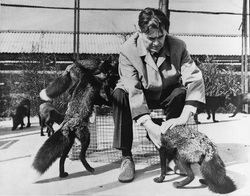 In an earlier post, I detailed the life and work of Nettie Maria Stevens, the namesake of our new calico cat. Nettie Stevens is known for her discovery of the X and Y chromosomes as the basis for sex determination. While researching the post, I found myself in another internet rabbit hole and I wanted to share some of the things I learned about cat genetics because, it turns out, calico cats are an excellent lesson in genetics.
In an earlier post, I detailed the life and work of Nettie Maria Stevens, the namesake of our new calico cat. Nettie Stevens is known for her discovery of the X and Y chromosomes as the basis for sex determination. While researching the post, I found myself in another internet rabbit hole and I wanted to share some of the things I learned about cat genetics because, it turns out, calico cats are an excellent lesson in genetics.The genetics of cat fur color (like the genetics of human hair color) are rather complex. There are many different genes that create the spectrum of coat colors and patterns found in domestic cats. In other mammals, white fur color alone has been linked to at least six genes (MITF, EDN3, EDNRB, PAX3, SOX10, and SNAI2). For this discussion, I will focus only on the gene loci that create the calico pattern: agouti (A), orange (O), and spotted (S). Based on the combined expression of these genes, some cats are tortoiseshell, a mix of black and orange and some cats are calico, a mix of black, orange, and white. Because the Orange gene is on the X chromosome, most torties and calico cats are female. There are rare cases of male cats with Klinefelter syndrome (XXY) that can have these fur color variants.
 |
| Figure 1 Schmidt-Kuntzel, et al., 2009 |
| The genetics of the tortoiseshell/calico cat |
The specifics of how this happens is actually pretty amazing. (For further details of the process, check out my post on Nessa Carey's book Junk DNA.) In short, a long non-coding RNA known as Xist (X-inactive specific transcript) turns off one copy of the X chromosome in each cell; on the opposite strand of DNA, a gene called Tsix is found. Xist and Tsix have mutually exclusive expression, which ensures that only one X chromosome is inactivated in each cell. X chromosome inactivation occurs at the 8 cell stage of the embryo. Different cells inactivate different copies of the X chromosome, which means some cells express alleles for orange and white and other cells express black and white alleles. These 8 cells then divide and produce the millions of cells that make up a cat. This random pattern of gene inactivation leads to the pattern observed in Nettie and other calicos.
 |
| Carbon copy (left) is a clone of Rainbow (right) |
| maneki-neko calico cat figurines are thought to bring good luck |
Calico cats like our Nettie offer excellent lessons in genetics as they higlight X-linked genes and dosage compensation. After all this reading, I think I will take advantage of cat genome sequencing to discover the specific mutations in our cat. I learned more than expected about cat genetics and hope to share these lessons with you soon. For now, if you want to learn more about the genetics of cats, you should check out Herding Hemingway's Cats by Kat Arney.




